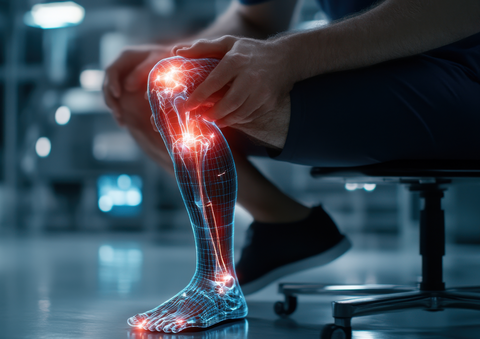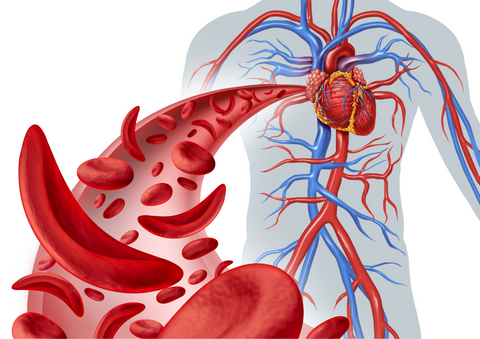Poor circulation in the legs is a common problem that can lead to discomfort, swelling, fatigue, and more serious conditions if left untreated.
When blood flow to the legs is restricted, it can result in symptoms like numbness, tingling, cramps, and a feeling of heaviness.
Understanding the causes of poor circulation in the legs and implementing strategies to improve blood flow can help alleviate discomfort and reduce the risk of complications.
In this blog, we’ll explore five effective ways to improve circulation in the legs and enhance overall vascular health.
Let's dive in!
What Causes Poor Circulation in Legs?
Several factors can contribute to poor circulation in the legs, including:
-
Atherosclerosis: The buildup of fatty deposits in the arteries can narrow blood vessels, restricting blood flow.
-
Varicose Veins: Weakened or damaged veins can cause blood to pool in the legs, leading to reduced circulation.
-
Sedentary Lifestyle: Lack of movement can cause blood to pool in the lower extremities, impairing circulation.
-
Obesity: Excess weight puts additional pressure on the blood vessels, leading to reduced circulation.
-
Diabetes: High blood sugar levels can damage blood vessels and nerves, affecting circulation.
-
Smoking: Smoking damages blood vessels and reduces oxygen levels in the blood, leading to poor circulation.
With these causes in mind, let’s explore five ways to improve circulation in your legs.
5 Ways to Improve Poor Circulation in Legs
1. Take a Nitric Oxide Supplement
A nitric oxide supplement is one of the most effective ways to improve circulation in the legs.
Nitric oxide is a natural vasodilator, meaning it helps relax and widen blood vessels, allowing for better blood flow.
Supplements that boost nitric oxide production contain ingredients such as beet root powder and red spinach that help stimulate nitric oxide production.
By enhancing circulation, nitric oxide supplements can improve nutrient and oxygen delivery to the legs, reducing symptoms like cramps and fatigue and promoting overall vascular health.
We created Nitrox 40 with the intention of helping you get your blood circulation support daily.
As it boosts the body’s nitric oxide (NO) production, Nitrox 40 can support widening of blood vessels and enhance blood flow throughout the body.
With ingredients like organic beet root powder, mango fruit powder, and red spinach, Nitrox 40 supports healthy blood pressure, boosts energy and stamina, and promotes microcirculation to even the smallest capillaries.
Simply take one scoop a day and you're good to go!
|
2. Stay Active with Regular Exercise
Physical activity is one of the best ways to improve circulation in the legs.
Exercise helps stimulate blood flow, improve cardiovascular health, and strengthen the muscles around your legs, which helps veins pump blood back toward the heart.
Regular activities like walking, swimming, cycling, or even light stretching can promote better circulation and reduce the risk of blood pooling in the legs.
Aim for at least 30 minutes of moderate exercise most days of the week.
3. Elevate Your Legs
Elevating your legs is a simple and effective way to improve circulation and reduce swelling in the legs.
By raising your legs above heart level, you can help promote the return of blood to your upper body, preventing blood from pooling in the lower extremities.
Try lying down and propping your legs up on pillows or using a recliner to keep your legs elevated while you rest.
This practice can help relieve pressure on the veins and enhance circulation.
4. Wear Compression Socks
Compression socks are designed to help improve circulation in the legs by applying gentle pressure to the veins and helping blood flow back toward the heart.
These socks are especially helpful for people with varicose veins, diabetes, or those who spend long hours sitting or standing.
Compression socks can reduce swelling, prevent blood clots, and enhance overall circulation, making them an excellent tool for managing poor circulation in the legs.
5. Maintain a Healthy Weight
Excess weight can put additional pressure on your veins and blood vessels, impairing circulation in the legs.
Maintaining a healthy weight through a balanced diet and regular exercise can significantly improve circulation and reduce the risk of developing vascular issues like varicose veins or deep vein thrombosis (DVT).
If you are overweight, losing even a small amount of weight can help reduce pressure on your legs and improve blood flow.
Supporting Poor Circulation in the Legs
Improving circulation in the legs is essential for reducing discomfort and preventing more serious health issues.
By incorporating strategies like taking a nitric oxide supplement, staying active, elevating your legs, wearing compression socks, and maintaining a healthy weight, you can significantly enhance blood flow and promote overall vascular health.
If you experience persistent symptoms of poor circulation, such as swelling, pain, or numbness, it’s important to consult with a healthcare provider to rule out any underlying conditions and develop an effective treatment plan.
Thank you for reading!




